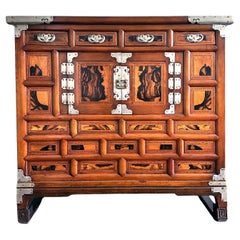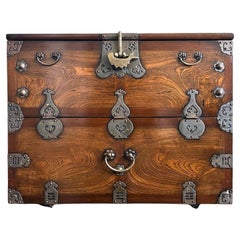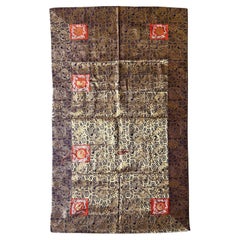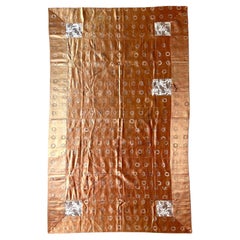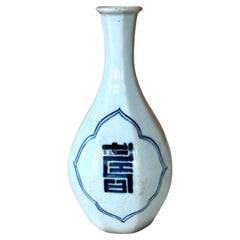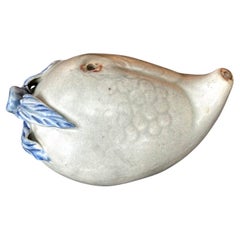TISHU Furniture
to
6
337
337
5
3
1
155
337
638
108
171
209
188
26
4
14
18
32
49
46
68
35
30
198
95
74
68
59
321
300
124
92
74
337
337
337
9
5
4
2
1
Period: 19th Century
Large Korean Head Side Chest Morijang Joseon Dynasty
Located in Atlanta, GA
A finely crafted Korean Morijang chest dated to the late 19th century toward the end of Joseon Dynasty. "Morijang" was traditionally used to keep house valuables such as jewelries an...
Category
Antique Late 19th Century Korean Other Furniture
Materials
Brass
Fine Antique Korean Bandaji Chest Gyeonggi Do Joseon Dynasty
Located in Atlanta, GA
A Korean Bandaji Chest circa late 19th century (toward the end of Joseon Dynasty). Bandaji is known as drop-front half opening chest and was traditionally used to store household val...
Category
Antique Late 19th Century Korean Other Furniture
Materials
Brass
Magnificent Antique Japanese Woven Brocade Kesa Monk's Robe Meiji Period
Located in Atlanta, GA
A stunning Japanese Kesa (Monk's Vestment) made from thirteen columns of patchworks of shimmering woven brocades with luxuriant golden threads. Dated to late 19th century of Meiji Period, the elaborate woven motifs on this kesa feature repetitive roundels dragon and phoenix intermixed with peonies and chrysanthemum blossoms. Two shades of contrasting gold threads were used on a striking purplish-blue background, with a dark metallic thread for the outer border and a brighter thread for the main body. The brilliantly woven fabric was possibly recycled from Noh costumes...
Category
Antique Late 19th Century Japanese Meiji Textiles
Materials
Brocade, Silk
Antique Japanese Embroidered Silk Kesa Monk's Robe Edo Period
Located in Atlanta, GA
A Japanese Kesa (Monk's Vestment) made from thirteen columns of patchworks of fine shimmering silk fabric of a salmon orange color, the shade of which changed subtly from different a...
Category
Antique 19th Century Japanese Edo Textiles
Materials
Brocade, Silk
Korean Ceramic Faceted Blue and White Bottle Vase Joseon Dynasty
Located in Atlanta, GA
A Korean blue and white long neck vase in bottle form with octagonal faceted surface from Joseon Dynasty (19th century). The elegant vase is cove...
Category
Antique 19th Century Korean Archaistic Ceramics
Materials
Ceramic
Fine Antique Korean Ceramic Water Dropper Joseon Dynasty
Located in Atlanta, GA
A fine porcelain water dropper from Korea circa 19th century of the late Joseon Dynasty. Water dropper is one of the essential scholar objects in the Confucius Joseon society where ink calligraphy was considered an important cultivation of an educated man. The water dropper is a small contained made to drop the water onto the ink stone to grind the ink stick for writing. These miniature objects were made in various forms as little wonders as a desktop accessory for the Scholar's study.
The water dropper on offer was made of porcelain and covered in a grey celadon glaze. It was molded in the form of a beach with finely sculpted stalk and leaves. A slight red was dotted on the two openings. The surface also has a carved grape or pomegranate motifs under the glaze. There is some slightly running of the celadon glaze on top. The base has residues of kiln grits.
Although the peach form was perhaps one of the most common ones among the Korean water droppers...
Category
Antique Early 19th Century Korean Other Scholar's Objects
Materials
Ceramic
Korean Headside Storage Cabinet Morijang Joseon Dynasty
Located in Atlanta, GA
A small Korean wood cabinet dated to the late Joseon Dynasty circa 19th century. The cabinet was known as "Morijang" in Korean and was traditionally used to keep valuables such as je...
Category
Antique 19th Century Korean Other Furniture
Materials
Brass
Antique Korean Small Table Soban Gangwon Do Joseon Dynasty
Located in Atlanta, GA
A small rectangular wood table from Korea circa late 19th century of Joseon Dynasty. Known as Soban (small plate), this type of light weight table was used primarily as individual dining...
Category
Antique Late 19th Century Korean Other Furniture
Materials
Wood
Antique Large Japanese Futon Cover with Resist Yuzen Dye
Located in Atlanta, GA
A large unframed Japanese Futonji textile art circa late 19th century toward the end of the Meiji period. Seamed together from four vertical sections of cotton in deep indigo color, ...
Category
Antique 1890s Japanese Meiji Textiles
Materials
Cotton
Antique Korean Porcelain Jar with Pheonix Design Joseon Dynasty
Located in Atlanta, GA
A korean white porcelain jar with underglaze blue paint circa late 19th century toward the end of Joseon Dynasty. Porcelain jars of this elongated form with swell shoulder, wide mout...
Category
Antique Late 19th Century Other Ceramics
Materials
Porcelain
Fine Korean Porcelain Jar with Chrysanthemum Design Joseon Dynasty
Located in Atlanta, GA
A fine Korean white porcelain jar with underglaze blue painting circa second half of 19th century, Joseon Dynasty. Considered associated with Punwon-ri kilns in Gwangju, these types ...
Category
Antique Late 19th Century Korean Other Ceramics
Materials
Porcelain
Antique Korean Porcelain Peony Jar Joseon Dynasty
Located in Atlanta, GA
A Korean white porcelain jar with underglaze blue painting of large peonies with leaves circa second half of 19th century, Joseon Dynasty. Considered associated with Punwon-ri kilns ...
Category
Antique Late 19th Century Korean Other Ceramics
Materials
Porcelain
Antique Korean Porcelain Peony Jar Joseon Dynasty
Located in Atlanta, GA
A Korean white porcelain jar with underglaze blue painting of large peonies with leaves circa second half of 19th century, Joseon Dynasty. Considered associated with Punwon-ri kilns ...
Category
Antique Late 19th Century Korean Other Ceramics
Materials
Porcelain
Fine Antique Tall Korean Medicine Chest Yakchang Provenance
Located in Atlanta, GA
A fine antique Korean medicine or apothecary chest from late Joseon Dynasty (circa 19th century). Known as Yakchang in Korean, this type of chest was used to sort and store herb medicines in its many small drawers. The prototype was originated in China, but this piece is distinctively Korean. The fine piece was made from Paulownia wood, which has an insect-repelling quality. Relatively tall, the Yakchang features a slightly overhanging and upturning pagoda plank top. The upper part has ten rows of smaller drawers, eight per row and eighty total. The lower part is centered with double doors with brass hinges and pull that open to a small storage space, which is surrounded by twelve larger drawers. Each drawer is fitted with yellow brass pulls and with two names of the herbs in gilt Hanja writings.
Examination of the construction and patina shows that this is an authentic antique piece that has seen extensive historical use. Provenance: Purchase from Lucky-Chosun Furniture, Seoul, Korea in 1986 and remains in an American collection until now. With an original invoice and also a freight invoice from Korea to Hongkong. There is also an insurance appraised by Sotheby's from 1997.
A tall medicine chest with similar configuration from a doctor's home in Yongin Folk Village is illustrated on plate 75 page 61 in the book "Korean Furniture and Culture" by Bokcha, Soon and Youngsoon.
To compare with another Medicine Chest, see illustration on page 47 in "Korean Antique Furniture...
Category
Antique 19th Century Korean Other Furniture
Materials
Brass
Antique Chinese Scholar Rock Yingde Stone on Display Stand
Located in Atlanta, GA
An intriguing Chinese scholar rock in vertical form presented on a custom hand-carved wood stand circa late Qing Dynasty. The greyish black stone is of Yingde type. Its upright form ...
Category
Antique 19th Century Chinese Qing Scholar's Objects
Materials
Stone
Chinese Lingbi Scholar Stone Arched Form on Display Stand
Located in Atlanta, GA
A small desk top Chinese scholar stones (also known as Gong Shi, meditation stone and spirit rock) fitted on a hand-carved wood stand circa late 19th century. The specimen is of a black Lingbi type stone in an arch form mimicking a horizontal mountain range. The wrinkles and folds on the black surface were perfectly weathered by elements for millenniums. Smooth and rugged at the same time, the mountain range shows a poetic formation that was often depicted in the ink scroll...
Category
Antique 19th Century Chinese Qing Scholar's Objects
Materials
Stone
Antique Korean Lacquer Wood Soban Table Joseon Period
Located in Atlanta, GA
An antique wood table from Korea from late 19th century (end of Joseon Dynasty). This type of light weight table is called "Soban" in Korean. which means "Small Tray". It was widely used primarily as individual dining table to present and serve foods, but also as small desk, incense burner holder...
Category
Antique Late 19th Century Korean Other Furniture
Materials
Wood
Antique Korean Lacquer Wood Soban Table Joseon Period
Located in Atlanta, GA
A small antique wood table from Korea from turn of the 20th century (end of Joseon Dynasty). This type of light weight table is called "Soban" in Korean. which means "Small Tray". It was widely used primarily as individual dining table to present and serve foods, but also as small desk, incense burner...
Category
Antique Late 19th Century Korean Other Furniture
Materials
Wood
Pair of Fine Miniature Satsuma Vase with Moriage Enamel Decoration by Seikozan
Located in Atlanta, GA
A pair of small ceramic vases with superb surface decorations made by Japanese studio Seikozan circa 1890-1910s (late Meiji Period). One of the many artist studios that specialized i...
Category
Antique 1890s Japanese Meiji Ceramics
Materials
Ceramic
Pair of Framed Fine Chinese Antique Embroidery Panels with Forbidden Knots
Located in Atlanta, GA
A pair of framed antique Chinese embroidery textile panels circa 19th century of Qing Dynasty. Each piece features two mirror-matchin...
Category
Antique 19th Century Chinese Qing Textiles
Materials
Brocade, Silk, Giltwood
Large Exceptional Japanese Ceramic Moriage Moon Flask Vase Meiji Kinkozan
By Kinkozan
Located in Atlanta, GA
A large and rare Japanese ceramic vase of exceptional quality from late Meiji period circa 1900-10s by Kinkozan (1645-1927). One of the largest studio manufacturers of the export cer...
Category
Antique Late 19th Century Japanese Meiji Ceramics
Materials
Ceramic
Rare Japanese Porcelain Incense Burner with Inlays Makuzu Kozan
By Makuzu Kozan
Located in Atlanta, GA
A porcelain incense burner (koro) made by Japanese potter Makuzu Kozan (also known as Miyagawa Kozan, 1842-1916) circa 1890s-1900s (end of Meiji Period). The koro features an elegant...
Category
Antique Late 19th Century Japanese Meiji Ceramics
Materials
Ceramic
Antique Korean Money Chest Ton-Kwe Joseon Dynasty
Located in Atlanta, GA
A Korean top-lid chest on elevated carved legs circa late 19th century of Joseon Dynasty. Known as coin chest (Ton-Kwe in Korean), this type of chest was originally used for storing ...
Category
Antique 19th Century Korean Other Furniture
Materials
Iron
Antique Korean Book Bandaji from Gyeongsang Do
Located in Atlanta, GA
An antique Korean wood Bandaji cabinet from Yecheon area in Gyeongsang Do (southern part of Korean Peninsular) circa late 19th century Joseon Dynasty. This particular Bandaji features a partial drop-down front door and extended top plank with upturned end. The relatively plain hardware indicates that its origin was likely from the Northern part of the Gyeongsang Do. The construction suggests that the use of the piece might be to store books or manuscript, known as Ch'aek Bandaji. The cabinet was made from stained pine wood and fitted with black iron hardware. It is supported on carved curvy legs...
Category
Antique Late 19th Century Korean Other Furniture
Materials
Iron
Antique Korean Bandaji Changhung Type from Jeolla Do
Located in Atlanta, GA
An antique Bandaji chest from Korea circa late 19th century Joseon Dynasty. The relatively small open-front cabinet was constructed from stained elm wood and fitted with thin hammere...
Category
Antique 19th Century Korean Other Furniture
Materials
Iron
Antique Korean Small Wood Box Joseon Dynasty
Located in Atlanta, GA
A small Korean antique box circa late 19th century of Joseon Dynasty. The square form box was constructed with thick hardwood planks on all side (appears to be elm) with a noticeable...
Category
Antique 19th Century Korean Other Furniture
Materials
Brass
Antique Japanese Tsubo Jar with High Relief Crab Design
Located in Atlanta, GA
A Japanese stoneware tsubo (storage jar) circa 19th century (Meiji period), likely made in one of the Shigaraki or Echizen kilns. The jar has a thick robust body, and a short-neck ri...
Category
Antique 19th Century Japanese Meiji Ceramics
Materials
Ceramic
Lacquered Korean Low Coffee Table with Elaborate Inlays
Located in Atlanta, GA
A Korean black lacquered wood low table with elaborate inlay works circa late Joseon dynasty (late 19th century to turn of 20th century). The low table, supported by slightly curved ...
Category
Antique Late 19th Century Korean Other Furniture
Materials
Brass
Framed Japanese Antique Embroidery Sennin Tapestry Meiji Period
Located in Atlanta, GA
A stunning Japanese embroidery tapestry circa 1880s-1900s from late Meiji period, presented with an original wood frame with inner gold trim. The tour-de-force embroidered tapestry s...
Category
Antique 1890s Japanese Meiji Textiles
Materials
Silk, Giltwood
Rare Korean Ceramic Brush Holder Joseon Dynasty
Located in Atlanta, GA
A rare Korean porcelain brush holder in Banana Leaves pattern from late Joseon dynasty circa 19th century. Cherished by the scholars, this brush...
Category
Antique 19th Century Korean Other Ceramics
Materials
Ceramic
Fine Japanese Satsuma Vase with Superb Decoration by Seikozan
Located in Atlanta, GA
A ceramic vase in tapered square form made by Japanese studio Seikozan circa 1890-1910s (late Meiji Period). One of the many artist studios that specialized in satsuma ware, Seikozan...
Category
Antique 1880s Japanese Meiji Ceramics
Materials
Ceramic
Japanese Glazed Ceramic Bowl by Makuzu Kozan
By Makuzu Kozan
Located in Atlanta, GA
Tri-pod ceramic bowl likely used as an incense burner (koro) by Japanese Imperial potter Makuzu Kozan (1842-1916) circa late Meiji period. The signature indicates that it was produce...
Category
Antique 1880s Japanese Meiji Ceramics
Materials
Ceramic
Japanese Woodblock Print Famous Views of the Sixty-Odd Provinces by Hiroshige
By Utagawa Hiroshige (Ando Hiroshige)
Located in Atlanta, GA
Artist: Utagawa Hiroshige (1797 - 1858)
Series: Pictures of Famous Places in the Sixty-odd Provinces
Number: 44 Oki Province: Takuhi Shrine
Medium: Woodblock Print
Date: 1853 (Kaei 6), 12th month
Number of Prints: 70/70 (inc. Title Page)
Format: Vertical Oban
Size (H x W): 14" x 9.25" print only.
Publisher: Koshimuraya Heisuke (Koshihei)
Blockcutter's mark: Hori Ko-Sen
Signature: Hiroshige hitsu
Additional marks: Censor's seals: aratame, Ox 12
Displayed with mat and gilt wood frame.
Reference: For an identical print, see the collection of MIA (Minneapolis Institute of Art) Accession Number P.75.51.398; MFA...
Category
Antique 1850s Japanese Edo Prints
Materials
Paper
Japanese Silk Suijaku Scroll Nyorai-Kojin with Mixed Buddhism and Shinto Deities
Located in Atlanta, GA
A Japanese silk Suijaku hanging scroll beautifully presented in a custom wood shadow box frame from Edo period (circa 18-19th century). The scroll, surmounted on golden brocade was painted in fine details with gouache, ink and gold powder highlight, served as a Suijaku mandala for the worshippers. Honji Suijaku is a complicated religious concept uniquely developed in Japan. It mixed and hybrid the Buddism deities with native shinto spirits (known as Kami), which were seen as local manifestations (the suijaku, literally means a "trace") of Buddhist deities (the honji literally the original ground). The original idea may lie with the synergetic strategy to spread Buddism by making it more relatable to the local population who had already worshiped Shinto gods. The paradigm, adopted in the 10th century from an orignal Chinese concept, remained a defining feature of Japanese religious life up to the end of the Edo period (1868). Instead of being confined to deities, its application was often extended to historical figures as shown on this scroll.
This long hanging scroll depicts an arrangement of 21 figures including Buddhism and Shinto deities as well as two historical figures on the bottom. Each figure was name-tagged in Kanji for easy identification by the worshippers. It was used in the temple or shrine so that when the worshipper prayed in front the mandala, they prayed simultaneously to all the deities.
On the very top, sits Nyorai-Kojin, a hybrid deity of Nyorai Buddha and Kojin, the kaki for fire, stove and kitchen. From the top to bottom and left to right, here is the list of the deities: Kanon with Thousand Hands, Kanon with Willow Branch, Monju Bosatsu...
Category
Antique Early 19th Century Japanese Edo Paintings and Screens
Materials
Silk, Wood
Large Japanese Ceramic Vase by Makuzu Kozan Meiji Period
By Makuzu Kozan
Located in Atlanta, GA
A large Japanese ceramic vase by the celebrated Meiji imperial potter Makuzu Kozan (1842-1916) circa 1880-1890s. Dated to his underglaze phase post 1887 after he successfully mastered the new colors available from the west and used them to the best advantage in his work deeply rooted in Japanese aesthetics. The vase has an impressive size and was potted in the classic baluster form with an elegant proportion. The surface is decorated using a combination of techniques of low relief sculpturing...
Category
Antique Late 19th Century Japanese Meiji Ceramics
Materials
Ceramic
Chinese Altar Table with Rare Silver Wire Inlays
Located in Atlanta, GA
A Chinese wood altar table or console table circa late 19th to early 20th century (late Qing dynasty to the Republic era). The table was constructed with mixed wood types. The legs a...
Category
Antique Late 19th Century Chinese Qing Furniture
Materials
Silver
Japanese Satsuma Ceramic Dish with Fine Decoration by Kinkozan
By Kinkozan
Located in Atlanta, GA
A satsuma ceramic dish made by Kinkozan studio circa 1980-1900s in the late Meiji Period. The dish with a thick robust wall is supported by a large ring base and features finely deta...
Category
Antique Late 19th Century Japanese Meiji Ceramics
Materials
Ceramic
Fine Korean Iron Box with Silver Inlay Joseon Dynasty
Located in Atlanta, GA
A fine Korean iron box that was traditionally used to store tobacco leaves dated to the late Joseon Dynasty circa 19th century. The box is made from iron and has a heavy weight, although the wears along the edges of the lid and base exposes a bronze metal color underneath, indicating the iron metal may contains a high level of copper. The surface was beautifully decorated with elaborate silver inlay that covers the entire surface except the base. The extraordinary workmanship depicts a pair of deer within the circled square (shape of heaven and earth) and a lined background on the long sides and a crane with spread wings on the shorter sides. Both animals were associated with longevity. Their eyes were highlighted with copper inlay, adding a lively touch to the animation. The lid is centered with a Chinese character "Xi" (Paired-Hui in Korean), which means double happiness. (In Chinese culture, it is often used in a wedding ceremony). The large symbol was set on geometrical background of tightly scrolling diamond pattern surrounded by stylized Ruyi mushroom heads, another floral longevity symbol. Archaic fret cloud band borders the entire perimeters of the lid and the container.
Tobacco was introduced to Korean in the first half of the 17th century and gradually gained popularity. When the tobacco was started being smoked in shredded form instead of rolled leaves, there rose the production of the smoking accessories, with some in fine quality as luxury items for the elite. The accoutrement such as this box is a fine example made in late Joseon dynasty, using extensive silver inlay, a technique called "jjoeum-ipsa", in which the silver wires were hammered into the scorched iron surface to create the elaborate design.
Similar boxes with variation of shape and motifs are in the collection of several major museums. Compare the box with item Gu 754 in the National Museum of Korea; item 22.78 in MET NYC and M.240:1, 2-1926 in V& A Museum in London. The most closely related example we found is item C232 in the collection of the Museum of East Asian Art...
Category
Antique 19th Century Korean Other Metalwork
Materials
Silver, Copper, Iron
Fine Miniature Japanese Kodansu with Lacquer Inlays
Located in Atlanta, GA
A fine Japanese miniature kodansu constructed from Kaki wood (Persimmon) circa 19th century, late Meiji period. With its expressive exotic wood grains and exposed tenon construction,...
Category
Antique Late 19th Century Japanese Meiji Lacquer
Materials
Wood
Fine and Rare Miniature Satsuma Vase by Taizan Yohei
Located in Atlanta, GA
A very fine miniature ceramic vase in satsuma ware by Taizan Yohei IX (1864-1922) circa 1880-1890s of late Meiji period. The vase with a broad flat should...
Category
Antique 1880s Japanese Japonisme Ceramics
Materials
Ceramic
Japanese Ceramic Vase with Delicate Carvings by Makuzu Kozan Meiji Period
By Makuzu Kozan
Located in Atlanta, GA
A delicate and rare Japanese ceramic vase by the important Meiji imperial potter Makuzu Kozan (1842-1916) circa 1887-1910. Dated to his underglaze phase post 1887 after he successful...
Category
Antique 1890s Japanese Japonisme Ceramics
Materials
Ceramic
Japanese Indigo Kasuri Ikat Traveling Cape
Located in Atlanta, GA
Known in Japanese as Bozugappa (priest's raincoat), this cape-like garment was worn by the travelers in Japan circa late 19th century to early 20th century (end of Meiji period). Derived from the cape worn by the Portuguese missionary, who first arrived in Japan in mid-16th century, this type of cape was originally reserved for the Japanese military...
Category
Antique 1890s Japanese Meiji Textiles
Materials
Cotton, Linen
Exquisite Japanese Lacquer Maki-e Suzuribako by Koma Kyūhaku Edo Period
Located in Atlanta, GA
One of the finest Japanese Maki-e Suzuribakos (ink box) we have on offer, the roiro color box showcases an ambient nocturnal scene in which two shakudo inlaid crows perched on the handrails of a bridge (possible the Uji Bridge...
Category
Antique Early 19th Century Japanese Japonisme Lacquer
Materials
Stone, Metal
Early Chinese Export Silver Tea Service by Cutshing
By Cutshing
Located in Atlanta, GA
An early set of Chinese export sterling silver tea service circa 1840-70s. The service consists of a lidded tea pot, a creamer and a sugar bowl. The surface was beautifully decorated with chased high-relief dragons with tightly chased scales, slithering with open claws...
Category
Antique Late 19th Century Chinese Chinese Export Metalwork
Materials
Sterling Silver
Japanese Meiji Han Koto with Maki-e Lacquer Decoration
Located in Atlanta, GA
A rare Japanese Koto made from carved Paulownia wood and lavishly decorated with lacquer Maki-e circa late 19th century of Meiji Period (1868-1912). The ...
Category
Antique Late 19th Century Japanese Japonisme Lacquer
Materials
Wood
Rare Pair of Early Period Makuzu Kozan Takauki High-Relief Vases
By Makuzu Kozan
Located in Atlanta, GA
A stunning pair of ceramic vases with gilt, paint and high-relief decoration by imperial artist Makuzu Kozan (1842-1916, also known as Miyagawa Kozan) circa 1876-81 (late Meiji period). These vases belong to early period (1876-1881) of Kozan's repertoire, during which time the high relief sculpturing (known as Takauki ware) was used as a distinguished technique on top of the traditional gilt and paint ornaments of satsuma ware. Due to the relatively limited production and the fragile nature of these wares, not a large quantity of the examples remained in the first place, not mentioning a fine matching signed pair in such impressive sizes.
Not only a rarity, this pair of vases is also superb in workmanship, thus the fine example of the work from that short and unique period of the artist's career before he switched to the underglaze period. In a conceptually mirrored fashion, the surface is richly decorated with flying cranes among large lotus leaves and flower, like an idyllic aqua scenery of pure poetry on a circular scroll. The high-relief appliques were rendered and composed in realistic fashion but with a dramatic touch. They are literally about to break the surface free, alive and in motion. The dark colors of the glaze were used to set a moody tone. The approach to create this type of ornamentations is more akin to sculpturing an ink painting in three-dimension than ceramic making. It is not hard to imagine the demand of both the artistry and the technique.
Both vases were signed as "Makuzu Kozan Kiln" and each further with another name and seal, which are most likely the individual artist involved in the making process. Similar signatures can be seen in the reference book below.
For similarly Takauki vases, see Miyagawa Kozan Makuzu...
Category
Antique 1870s Japanese Japonisme Ceramics
Materials
Ceramic
Japanese Maki-e Lacquer Portable Sagejubako Theme of Three Winter Friends
Located in Atlanta, GA
Sagejubako is a portable lunch or picnic set that became popular in the early Edo period when an additional meal was added between breakfast and dinner. It normally consists of a han...
Category
Antique 19th Century Japanese Japonisme Lacquer
Materials
Lacquer
Japanese Antique Gilt Wood Amitabha Buddha on Loctus Throne Statue
Located in Atlanta, GA
A Japanese carved wood Amitabha (Amida) Buddha statue with residual gold leafed surface circa 19th century (late Edo period). The buddha is seated in the padmasana position on an elevated double lotus throne, under a small lotus halo canopy. His right hand is held in abhaya mudra which means fearlessness in Sanskrit. The mudra symbolizes protection, peace, and fearless. His left hand gently resting on his thigh. Dressed in a flowing robe with open chest, the statue showcases a classic iconography found prominently in Japanese Buddhism art during Edo to Meiji period, characterized by the double lotus throne and a particularly serene meditative facial expression, highlighted by inset gemstones...
Category
Antique 19th Century Japanese Edo Sculptures and Carvings
Materials
Gold Leaf
Large Art Nouveau Ceramic Landscape Plate with Luster Glaze by Clement Massier
By Clement Massier
Located in Atlanta, GA
A large wall-hanging ceramic platter by French artist Clement Massier (1811-1917) made in his studio in Golfe-Juan, France, dated to August 31st of 1891. The Art Nouveau style plate ...
Category
Antique 1880s French Art Nouveau Ceramics
Materials
Ceramic
Unique Japanese Lacquer Maki-e Suzuribako with Woven Bamboo Cover with Tomobako
Located in Atlanta, GA
This Japanese suzuribako (ink box) of late Meiji Period (circa end of 19th century) is uncommon with its surface covered with woven basketry in che...
Category
Antique Late 19th Century Japanese Japonisme Scholar's Objects
Materials
Rattan, Wood, Lacquer
Large and Substantial Chinese Scholar Rock on Display Stand
Located in Atlanta, GA
A stunning upright Chinese scholar stone (also known as Gong Shi, meditation stone and spirit rock) of significant weight and volume is gracefully balanced on the wood display stand....
Category
Antique Late 19th Century Chinese Chinese Export Scholar's Objects
Materials
Stone
Japanese Maki-e Lacquerware Portable Picnic Set Sagejubako
Located in Atlanta, GA
Sagejubako is a portable picnic set that became popular in the early Edo period when an additional meal was added between breakfast and dinner. It normally consists of a carry case w...
Category
Antique 19th Century Japanese Japonisme Lacquer
Materials
Lacquer
Rare Japanese Lacquer Writing Box Suzuribako Meiji Period
Located in Atlanta, GA
A Japanese Lacquer writing box Suzuribako Meiji Period (1868-1912), likely circa late 19th century. This suzuribako is one of the most unusual boxe...
Category
Antique 19th Century Japanese Japonisme Lacquer
Materials
Lacquer
One of The Two Japanese Ceramic Vases Makuzu Kozan Meiji Period
By Makuzu Kozan
Located in Atlanta, GA
Two small nearly identical ceramic vases by Japanese Meiji imperial potter Makuzu Kozan (1842-1916), circa 1890-1900s. The vases were made in the form of jarlet with swelled shoulder...
Category
Antique Late 19th Century Japanese Japonisme Ceramics
Materials
Ceramic
Japanese Silk Embroidery Tapestry Meiji Period
Located in Atlanta, GA
A spectacular Japanese embroidered silk panel beautifully presented in a gilt frame suspended in a lucite shadow box with gilt wood border. The silk picture is dated to 1890-1910s toward the end of Meiji Period, when Japanese started to participate international expose by presenting its best art and craft. Elaborate embroidered silk tapestry like this was very popular among westerners due to its superb craftmanship and also exotic subject matter that was often derived from classic Japanese folklore, mythology and various motifs. The tapestry on offer is such an example. It depicts an old couple...
Category
Antique 1890s Japanese Japonisme Textiles
Materials
Fabric, Silk, Lucite
Antique Korean Embroidered Civil Rank Badge Joseon Dynasty
Located in Atlanta, GA
A fine Korean silk embroidered rank badge (Hyungbae in Korean) from Joseon Dynasty circa late 19th century. The badge features a design of double flying cr...
Category
Antique 19th Century Korean Other Textiles
Materials
Fabric, Silk, Wood
Japanese Lacquered Samurai Jingasa Hat Edo Period
Located in Atlanta, GA
A bespoken Japanese historical hat known as Jinggasa (militant hat) that was worn by samurai in Edo period (1603-1868) circa 18-19th century. There were several subtypes of Jingasa a...
Category
Antique 19th Century Japanese Japonisme Lacquer
Materials
Wood, Lacquer
Large Lacquered Wood Antique Burmese Buddha Statue
Located in Atlanta, GA
A gilt and lacquered wood Buddha statue from Southeast Asia likely Burma, circa 19th century. The Buddha is depicted as seating on a slightly taper...
Category
Antique 19th Century Burmese Other Sculptures and Carvings
Materials
Wood, Lacquer
Japanese Lacquer Tray with Maki-e and Inlay Hara Yoyusai Edo Period
Located in Atlanta, GA
A lovely Japanese lacquer rectangular lacquer tray with a slightly scalloped corner and four L shape supporting feet by one of the most celebrated lacquer artist active in Edo period Hara Yoyusai (1772-1845). Yoyusai lived in Edo (Tokyo) and worked under the patronage of Lord Matsudaira. He operated a large workshop and had a very prolific output of lacquer objects. Most survived pieces being inro...
Category
Antique 19th Century Japanese Japonisme Lacquer
Materials
Wood, Lacquer
Extraordinary Chinese Scholar Rock Ying Stone on Stand
Located in Atlanta, GA
The Chinese scholar rock on offer here is a wonderful example of Ying (also known as Yingde stone), a less common type than Lingbi or Taihu. Gray in color, it has an extraordinary up...
Category
Antique 19th Century Chinese Qing Scholar's Objects
Materials
Stone
